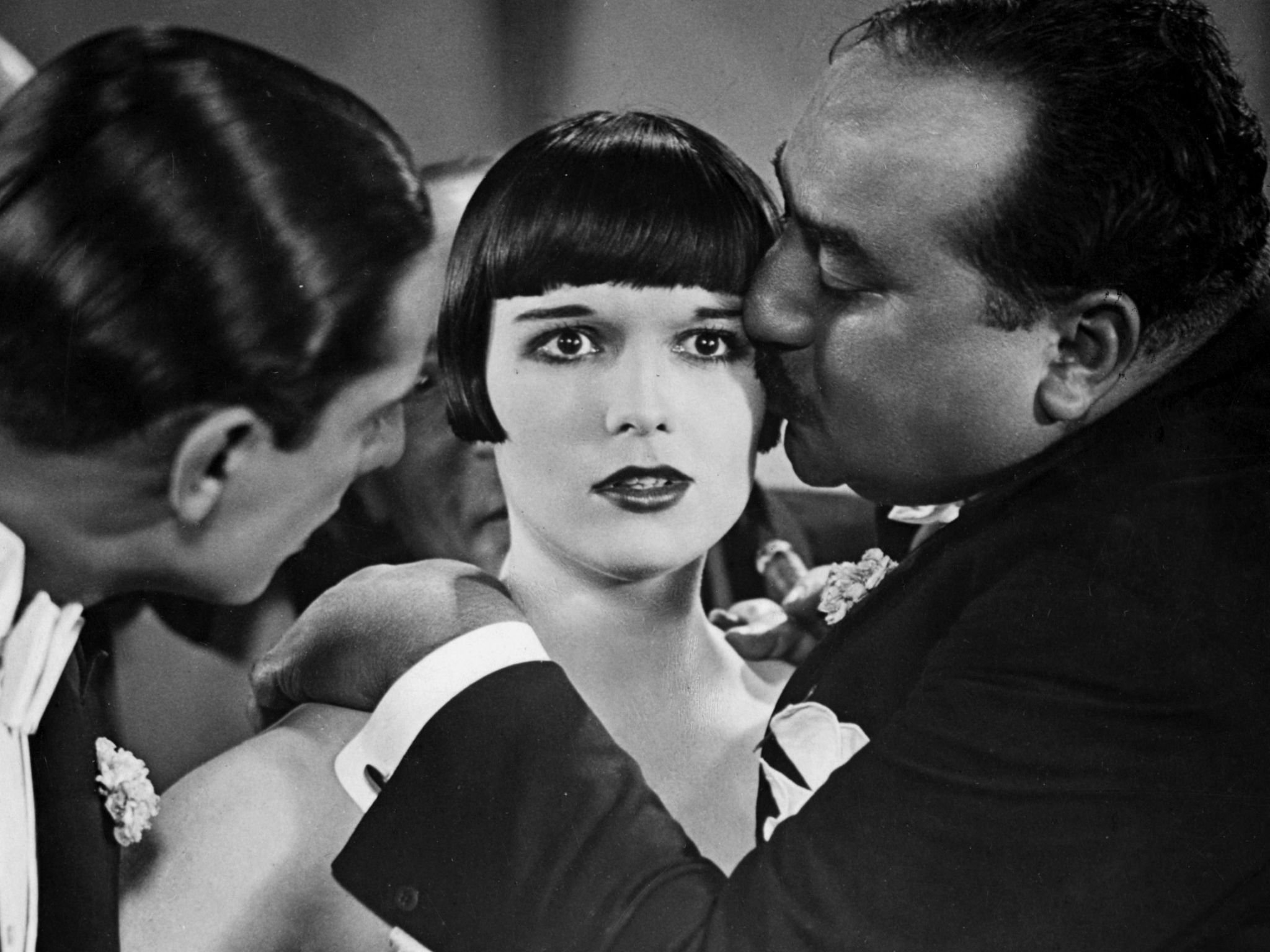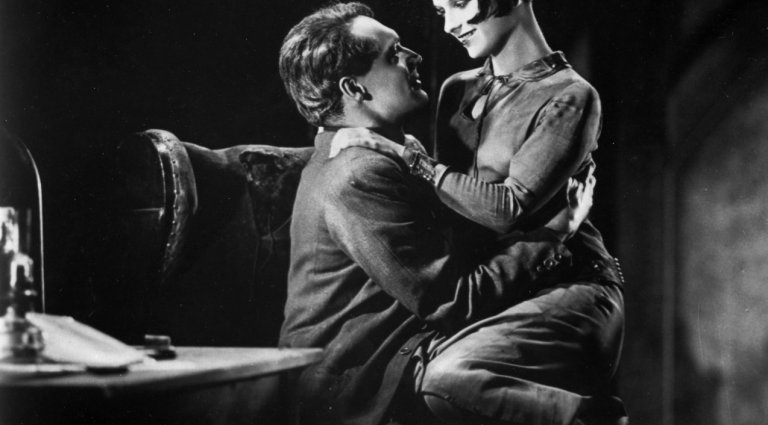
14 Eki ‘PANDORA’S BOX WITH THE LID OFF!’: LULU’S MISADVENTURES IN LONDON
by Pamela Hutchinson
This is an extended version of a paper that I gave at the British Silent Film Festival Symposium at King’s College London on 7 April 2017. My book on Pandora’s Box (1929) is forthcoming from BFI Palgrave.
W. Pabst’s Die Büchse der Pandora (Pandora’s Box, 1929) is an adaptation of Frank Wedekind’s Lulu plays, but in many places a very loose one. Those German plays are about thirty years older than the film, a Weimar-era classic that marries traces of Expressionism with the late-1920s sobriety of the Neue Sachlichkeit movement. Pandora’s Box was filmed in Berlin, or at least in a former zeppelin hangar in Staaken, and its American star Louise Brooks identitfied its depiction of divergent sexualities and the sex trade with the city’s glamorous, permissive nightlife. Her evocative description of the city during the shoot, when she was staying at the famous Eden Hotel, begins: “Sex was the business of the town …”
“At the Eden Hotel, where I lived in Berlin, the café bar was lined with the higher-priced trollops. The economy girls walked the street outside. On the corner stood the girls in boots, advertising flagellation. Actors’ agents pimped for the ladies in luxury apartments in the Bavarian Quarter. Race-track touts at the Hoppegarten arranged orgies for groups of sportsmen. The nightclub, Eldorado, displayed an enticing line of homosexuals dressed as women. At the Maly, there was a choice of feminine or collar-and-tie lesbians. Collective lust roared unashamed at the theatre.”

There is only one named location in the film, however, and it is in this place that the fictional narrative bumps into historical circumstance – so in this case, geography carries crucial meaning. The final act of Pandora’s Box the film, just like the final act of Wedekind’s play of the same name, takes place in London – in a slum district most likely in the east of the city. Jack the Ripper walks these streets, and our heroine Lulu, reduced to prostitution, encounters him with fatal consequences. This murder is her dramatic destiny, and to understand the film more fully, which was possibly the first cinema adaptation of the plays to feature London and the Ripper, we need to think about the British capital rather than the German one. To explore this topic I am going to examine three disappointing “misadventures” in London: the visits made by Frank Wedekind, Louise Brooks and the film itself.
Wedekind spent the years from 1887 to 1895 writing his Lulu plays: Erdgeist and Die Büchse der Pandora. This period, which he spent largely in Paris and Munich, is covered by his published journals (Diary of an Erotic Life), which generally offer far more detail of his social and sexual activities than his working practices. Towards the end of the writing process, though, he went to London, in January 1895. His entry for 24 January gives an unprecedented level of detail about his work. In the British Museum, he says, “I find masses of material for my Divine Birth”. Divine Birth was his working title for the plays. The next day follows a more familiar trajectory for Wedekind, despite a relatively early night:
“After lunch I get on the Underground at Charing Cross and travel to the Tower, look around the museum, the most boring and tasteless I have ever seen, travel under the Thames via London Bridge and come back home through the underworld, dine at seven o’clock and take the omnibus to the London Pavilion. Apart from a couple of authentic English children, I find nothing new and very little that’s congenial. I spend some time in a bar amid a pack of frightful whores, and go to bed at twelve o’clock.”
We can really only speculate on what “masses of material” Wedekind found in the British Museum reading room, but it seems reasonable to assume that he read about Jack the Ripper, an unidentified murderer thought responsible for killing several female sex workers between 1888 and possibly 1891 in the Whitechapel area, who was to become a character in his play. The news of the Ripper’s killings was fairly recent, in fact they happened after Wedekind began writing his plays, but a trip to the Museum would have provided some more detail about the nature of his crimes – specifically I think the amount of material widely shared in newspapers such as letters giving a supposed insight into the killer’s psychology, and also the distinctive mutilation of the bodies, which led to his gruesome nickname. Most of the victims were disemboweled, with organs including hearts and uteruses removed from the scene.
If his description is correct, then Wedekind’s trip to London’s “underworld”, or red-light district, was probably further west than the Ripper’s patch. As so often in the journal Wedekind here mixes enthusiasm with disgust in his accounts of paying or seeking to pay for sex, and the comparison between his disdainful sex tourism and his rather jaded review of the Tower of London is almost funny. We could speculate on whether his encounter with sex workers in two districts, feeds into his depiction of Lulu’s clients – a strange mix of rich and poor men, designed to mirror the suitors she has had earlier in the plays. Jack the Ripper, her final client, is the mirror of Schön, and often played by the same actor.
Wedekind may also have read about prostitution in the city, including the Pall Mall Gazette’s sensational investigation into child prostitution in 1885, The Maiden Tribute of Modern Babylon, which controversially included a sting in which a mother was caught by the editor W. T. Stead agreeing to sell her own 13-year-old daughter for £5. Sex may have been the business of London but, as the second diary extract implies (“authentic English children”), Wedekind was no stranger to this particular sector. Child prostitution is a theme that reverberates through his journal and the plays both. Lulu, who was “rescued” from the café scene as a young girl by her patron Schön, is frequently described as not just sexy, but also childlike and closely resembling her own mother. There is a grotesque scene in the play Pandora’s Box, not in the film, where a group of investors in Jungfrauaktien, that is shares in a funicular railway running up the Jungfrau or more literally, virgin shares, stand by while one of their number is persuaded to offer her 12-year-old daughter to a group of older men. Schön’s patronage of Lulu and common-or-garden child prostitution are linked throughout the drama.
Did Wedekind use his “masses of material” in the finished play? We must remember that he was forced to edit and tone down the material in the Lulu plays to get them published and performed, but by naming his murderer as the Ripper, he introduces the idea of evisceration. There appears to be no explicit reference to Jack mutilating Lulu’s body in the play – unless you look for it. At the opening of the play’s final act, Lulu empties a basin of rainwater. Her death, when it comes, takes place just off-stage and when Jack re-enters the room he is carrying the basin, ostensibly to wash his hands. The first implication being that it was a bloody murder and the second that he has removed something from the scene. Edward Bond’s 1980 English translation chooses to make this explicit. Lulu cries: “He’s slitting me up!” and then Jack emerges with a newspaper parcel, saying: “When I am dead and my collection is put up for auction, the London Medical Society will pay three hundred pounds for the prodigy I have conquered tonight.”
There is no such hand-washing or parcel-carrying in Pabst’s Pandora’s Box. Brooks was dismayed by this, saying: “the movie should have ended with the knife in the vagina”. However, the basin makes an appearance at the outset of the film’s final act, and I think there is in fact a suggestion of the Ripper’s bloody deed, which we will discuss after pudding.
Click here to read the full article.


